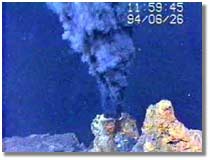 |
 September
11, 2003 - Patriot Day September
11, 2003 - Patriot Day
|
 |
"On this second anniversary of September 11, we all
know that the events of that day have changed America and Americans
forever. They have opened the box of the unimaginable and released
the unthinkable. For the nation, its institutions, and its citizens,
there is a loss of innocence about the security of our land and
of our lives. In its place, we find a new vigilance for the unexpected,"
noted agency Director Rita Colwell and Deputy Director Joseph Bordogna
in a message to NSF staff.
Read about NSF and Homeland Security at http://www.nsf.gov/od/lpa/news/media/01/nsf_response.htm (posted September 10, 2003)
|
 |
|
Atmospheric
Science Goes to Ground: Researchers Present New Findings on the
Natural Hydrogen Cycle New evidence is emerging
on the probable effects of an anticipated reliance on hydrogen as
a fuel. In the August 21 issue of the journal Nature, a
group of researchers from the California Institute of Technology
and other institutions reports results of a study of the atmospheric
chemical reactions that produce and destroy hydrogen in the stratosphere.
Funded in part by the National Science Foundation, the study concludes
that most of the hydrogen eliminated from the atmosphere goes into
the ground, and therefore that scientists will need to turn their
focus toward developing an understanding of soil destruction of
hydrogen to accurately predict whether hydrogen emissions will eventually
accumulate in the air.
More... (posted
August 22, 2003)
|
 |
|
 |
Confocal microscope images of Pseudomonas syringae pv. tomato DC3000 growing in the leaf intercellular spaces of the model plant Arabidopsis thaliana. The bacteria are marked with green fluorescent protein, which contrast with the red fluorescence of chloroplasts in plant cells.
Credit: W.-L. Deng and A. Collmer, Cornell University. |
Genome Sequence for Tomato-Infecting Microbe May Show How Bacteria Adapt to Plant Defenses
Scientists have sequenced the genome of the microbe that causes bacterial speck disease in tomato plants and have reported preliminary information about the roles of the more than 5,500 genes, including clues to how the bacterium infects plants that are constantly trying to defend themselves against pathogens. The bacterium's host-infection mechanism is also similar to that used by many other plant, animal and human pathogens, including a number identified as priority targets for the nation's biodefense efforts. "This model organism will give researchers a leg up on learning about pathogenesis for many other bacteria," said Jane Silverthorne, a program director in the National Science Foundation's Plant Genome Research Program, which funded the project.
More... (posted
August 22, 2003)
|
 |
|
 |
A "black smoker" vents atop a 10-meter-high chimney, with an internal temperature of 342°C. Considered a "real chugger" by the National Oceanic and Atmospheric Administration's Pacific Marine Environmental Laboratory Vents Program, this vent is about 250 miles south of Finn, the vent that yielded the strain 121 sample.
For additional footage, see: http://www.pmel.noaa.gov/vents/
geology/video_other.html
Video courtesy of Pacific Marine Environmental Laboratory, NOAA. |
Microbe from Depths Takes Life to Hottest Known Limit
A newly discovered, single-celled microbe leads the hottest existence known to science. Its discoverers have preliminarily named the roughly micron-wide speck "Strain 121" for the top temperature at which it survives: 121 degrees Celsius, or about 250 degrees Fahrenheit. Previously, the upper known temperature limit for life had been 113° C (235° F). Announcing Strain 121's record-breaking ability to take the heat in the August 15 issue of the journal Science, researchers Derek Lovley and Kazem Kashefi write, "The upper temperature limit for life is a key parameter for delimiting when and where life might have evolved on a hot, early Earth; the depth to which life exists in the Earth's subsurface; and the potential for life in hot, extraterrestrial environments."
More... (posted August 22, 2003)
|
 |
|
New Report Identifies Grand Research Challenges for Information Systems
A report recently released by the Computing Research Association outlines five "Grand Research Challenges”: a post-disaster safety net, "cognitive partners" for humans, personalized lifelong learning environments, unfailingly reliable systems, and simplification of information technology. The result of a three-day workshop supported by NSF, the report encapsulates the discussions of 65 leading computer science and engineering researchers. The grand challenges relate to building the information systems of the future and provide long-term goals for the short-term activities of the research community.
More... (posted August 22, 2003)
|
 |
| |


|

